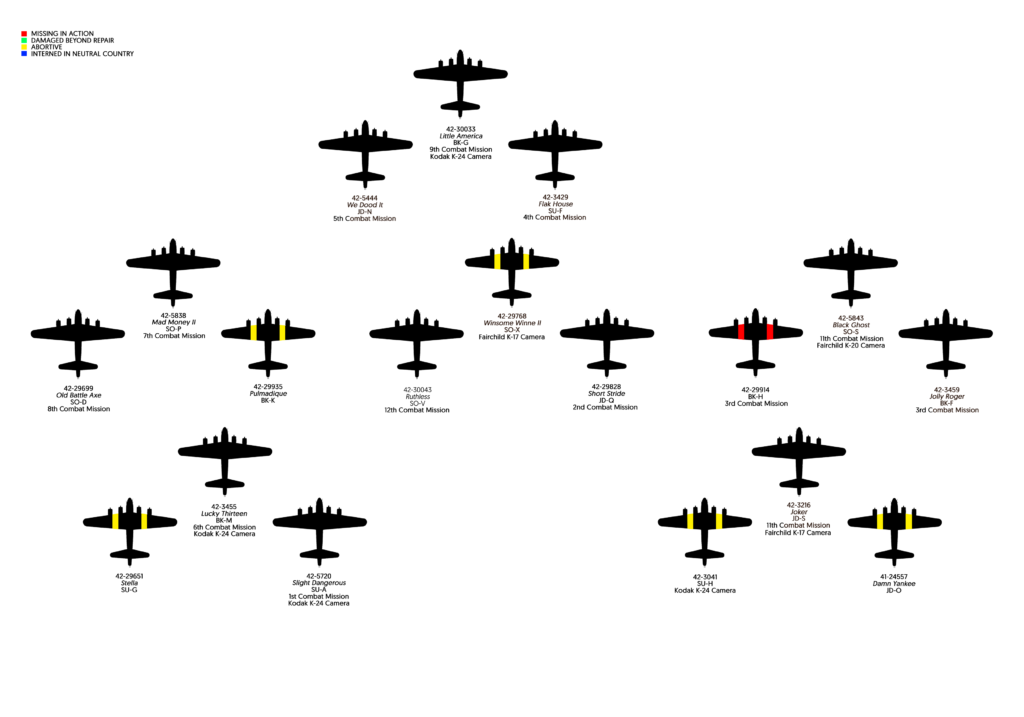77 years ago today, Lucky Thirteen flew her sixth combat mission.
Before beginning, it should be noted that Lucky Thirteen participated in a recall on 2 September 1943. Taking off at 3:15 pm, the 1BW was recalled from a strike due to bad weather. They returned with their loads at 6:45.
3 September 1943
VIII BC No. 90
Ramrod S. 26
384BG No. 20
The US 8AF launches 298 Boeing B-17s, escorted by 160 Republic P-47s, against the Caudron-Renault aircraft plant of Paris and airfields of Romilly-sur-Seine and Les Mureaux, France. Additional escort is provided by RAF 11 Group. The 384BG launches eighteen aircraft this day, led by CO 546BS MAJ George W. Harris, Jr. aboard Little America (42-30033). Lucky Thirteen leads the second element of the high squadron. Due to cloud cover over the primary, the 384BG bombs their secondary target: the airfield of Saint-André-de-l’Eure.
This strike is the first of three which CG USAAF GEN Henry H. Arnold witnesses during a seven-day visit to Great Britain.
Arnold had long been critical of MG Ira C. Eaker’s handling of the US 8AF. This was not just. When Eaker produced a plan in May as to what the 8AF hoped to achieve and how they would do so (the so-called “Combined Bomber Offensive”), Eaker stated that the 8AF required a minimum of 300 aircraft per strike to fly deep penetrations into Germany. When Arnold returned to active duty in June (following his second heart attack), he wasted no time criticizing Eaker and the 8AF for not flying enough deep penetrations. These criticisms led to the relief of CG VIII BC BG Newton Longfellow in July and CG VIII FC BG Frank O. Hunter in August. Engaged in a written war-of-words with Eaker, this visit was an attempt by Arnold to see for himself what was going on.
Arnold could not grasp why the 8AF did not regularly launch deep penetrations. When Eaker’s timetable called for some 1,192 heavy bombers by the end of September (the 8AF got 971), the 8AF still struggled to get 300 airborne. Arnold failed to understand the ratio of aircraft in service compared to those undergoing repair/maintenance/etc. Similarly, the losses of strikes like JUGGLER not only required a reserve of replacement aircraft, they also required a stream of replacements to refill the reserve. This was precisely the reason the 8AF had not yet launched another deep penetration since 17 August.
Unfortunately, today’s strike does not inspire confidence. After a visit to the 93BG is cut short (Arnold had little interest in B-24s), Arnold spent the morning at Bury St. Edmunds with the 94BG. Unbeknownst to Arnold at the time, when the 94BG abandoned the primary due to cloud cover, their selected target-of-opportunity, an airfield, was fake.
The numbers:
| Bombers Launched: | 298 |
| Bombers Effective: | 233 |
| Fighters Launched: | 160 |
| Bombers MIA: | 9 |
| Bombers Abort: | 65 |
| Fighters MIA: | 1 |
| Abort Rate: | 22% |
| Loss Rate: | 3% |
| E/A Destroyed: | 7 |
*Please note that the numbers above come from official US and German sources as victory claims cannot be relied upon. The numbers above do not account for RAF statistics.
Lucky Thirteen reports a failure in the waist position’s intercom. Likewise, one of the hydraulic transmissions in the ball turret is reported as leaking – the third consecutive report with this problem!
Another bit of interest in regard to this day – this night sees the third and final time a BBC recording team accompanies an RAF BC strike. An incredibly taxing process to attempt in a rumbling bomber, a pair of recording engineers record a period of intercom chatter while four de Havilland Mosquitos and 316 Avro Lancasters bomb Berlin, Germany. These are the only known audio recordings of aerial combat in the Second World War. No recordings were made accompanying a US strike.
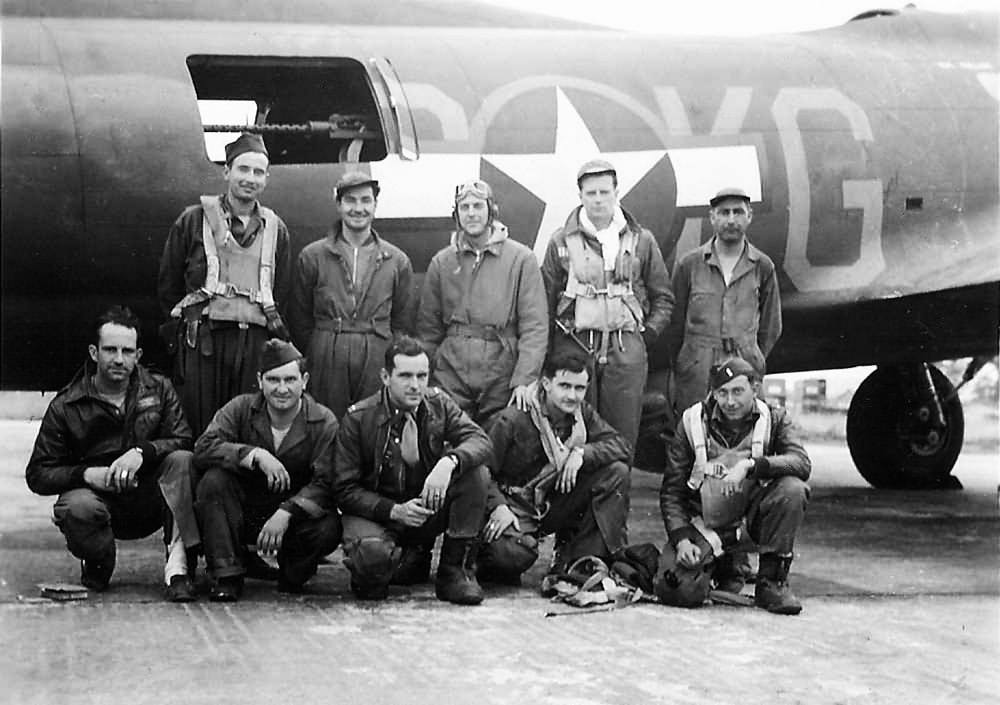
The crew of Little America, taken on 3 September 1943.
Back row (left to right):
TSGT Leonard M. E. Nealis (Engineer/Top Turret)
SSGT Dennis J. Lane (Ball Turret)
1LT Sidney P. Taylor (Tail/Observer)
MAJ George W. Harris, Jr. (Pilot/ CO 546BS)
SSGT Roland L. Killin (Waist)
Front Row (Left to Right)
TSGT Jerome B. Beaupre (Radio)
SSGT Aloysius W. Mizgorski (Waist)
1LT Bill E. Blount (Navigator)
1LT James H. Kelly (Co-Pilot)
1LT John E. Ryberg (Bombardier)
Little America flew as group lead this day, hence the crew arrangement above.
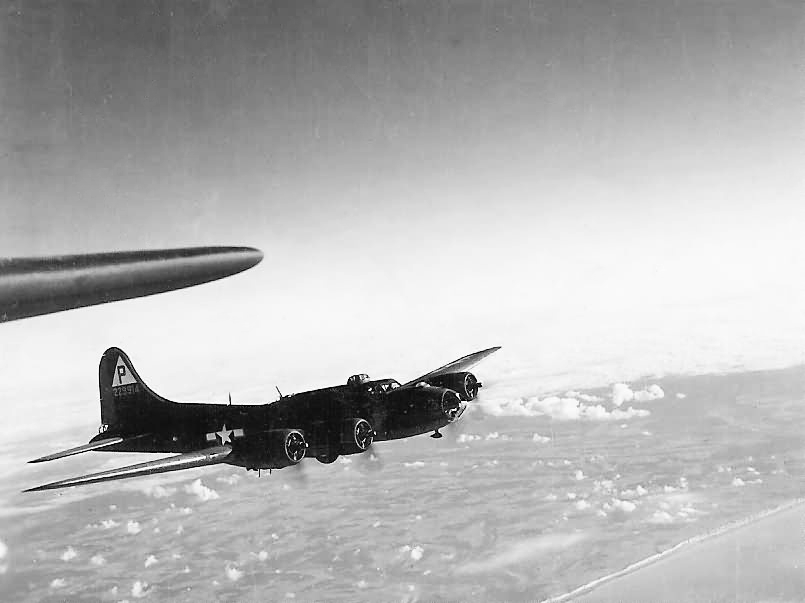
The 384BG’s combat loss this day: “H-How” (42-29914). She is shot down shortly after egress over the English Channel.
The 384BG’s formation chart from this day.
Five aircraft abort: Stella (42-29651) due to a sick bombardier (1LT James E. Seibel), Pulmadique (42-29935) due to turbocharger failure, Winsome Winne II (42-29768) due to a bad cylinder on an old No. 4 engine, “H-How” (42-3041) due to a rough No. 4 engine, and Damn Yankee (41-24557) due to low manifold on Nos. 1 and 3.
“H-How” (42-29914) is shot down shortly after egress over the English Channel. She is followed down by four enemy aircraft before ditching in the water. Her crew survives and are taken prisoner.
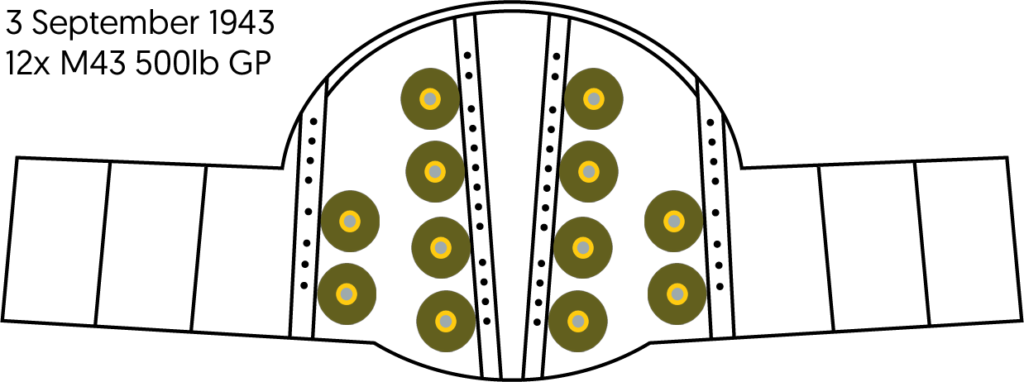
Lucky Thirteen‘s bombload for 3 September 1943.
The AN-M43 500 lb GP bomb was the most common bomb carried by US heavy bombers in the Second World War.
The previous day’s recall saw Lucky Thirteen carry 16 M31 300 lb GP bombs.

The 384BG’s strike route for 3 September 1943. The target was bombed at an altitude of 24,000 ft. Average temperature was -25 degrees.
All times in the AM.
| Start Engines: | 5:30 |
| Taxi: | 5:45 |
| Takeoff: | 6:00 |
| Feet Wet: | 8:03 |
| Feet Dry: | 8:18 |
| IP: | 8:57 |
| Target: | 9:07 |
| Secondary: | 9:49 |
| Feet Wet: | 10:04 |
| Feet Dry: | 10:30 |
| Home: | 11:24 |
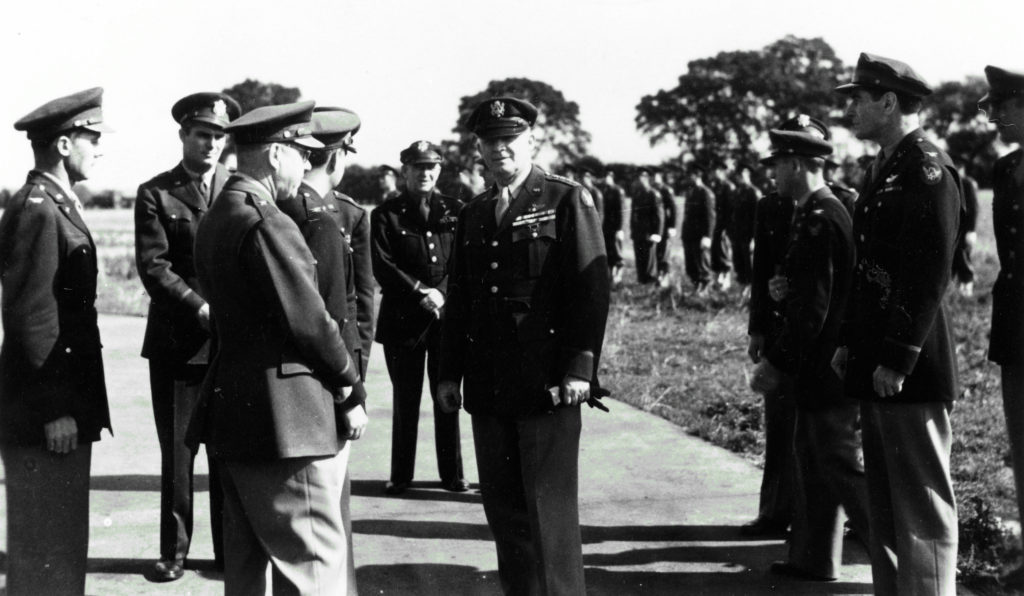
CG USAAF GEN Henry H. Arnold at Bury St. Edmunds on 3 September 1943.
You can see footage from his visit here.
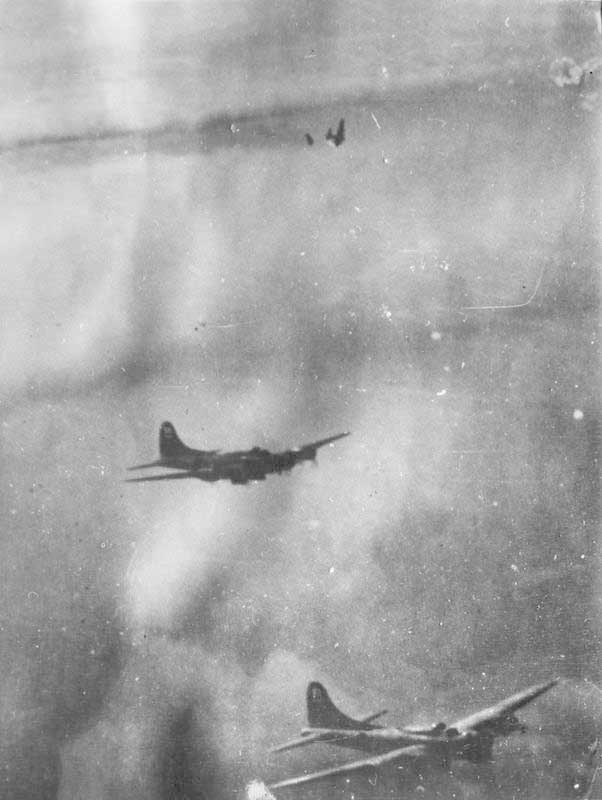
Elusive Elcy (42-5888, 94BG) loses control after an air-to-air missile blows off her left wing on 21 September 1943. She is the first US aircraft ever brought down by an air-to-air missile in combat. German interceptors had used air-to-air missiles since 21 May 1943 but it was not until 21 September 1943 that they managed to down a US bomber with one.
German interceptors regularly used air-to-air missiles to spread apart formations so that US bombers could be attacked without threat of interlocking return fire. CG USAAF GEN Henry H. Arnold’s diaries speak of him viewing a B-17 damaged by missile fire on 3 September 1943.
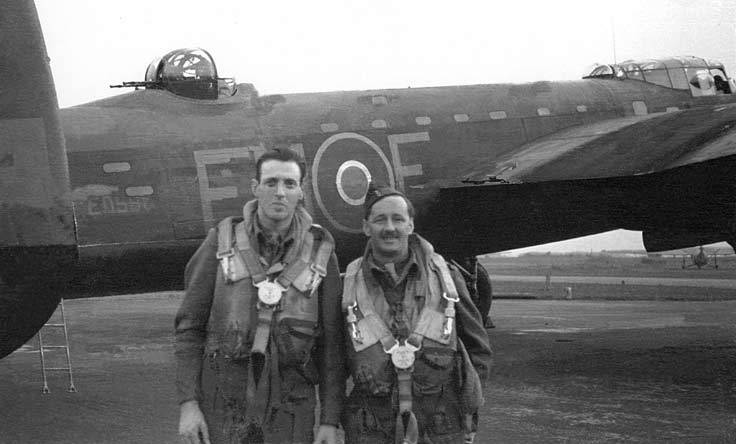
BBC engineers Reginald Pidsley and Wynford V. Thomas pose with “F for Freddy” (ED586, 207 Squadron). 22 Lancasters are lost on the night of 3 September, at a loss rate of 7%. “F for Freddy” is later lost on the night of 5 January 1944 over Stettin, Germany.
You can listen to the audio recorded this night, as well as read a transcript, here:
Despite popular misconception, the “combat audio” played in the films Memphis Belle and Combat America is not genuine. They were recorded in the studio.

A strike photo taken of the airfield at Saint-André-de-l’Eure. While this photo is undated, the bomb pattern matches the aiming point described in the after-action reports – targeting the barracks and workshop areas at a 322° heading.
The B-17’s strike camera was located under the floor of the radio compartment. Lucky Thirteen was one of the bombers carrying a strike camera this day, mounting a Kodak K-24. It is indeed possible that she took this photo.
Despite having a relatively short service life, Lucky Thirteen carried on different missions a Fairchild K-17, a Graflex K-21, and a Kodak K-24 strike camera. If any of you have one of these and would like to contribute it to her rebuild, please let us know!
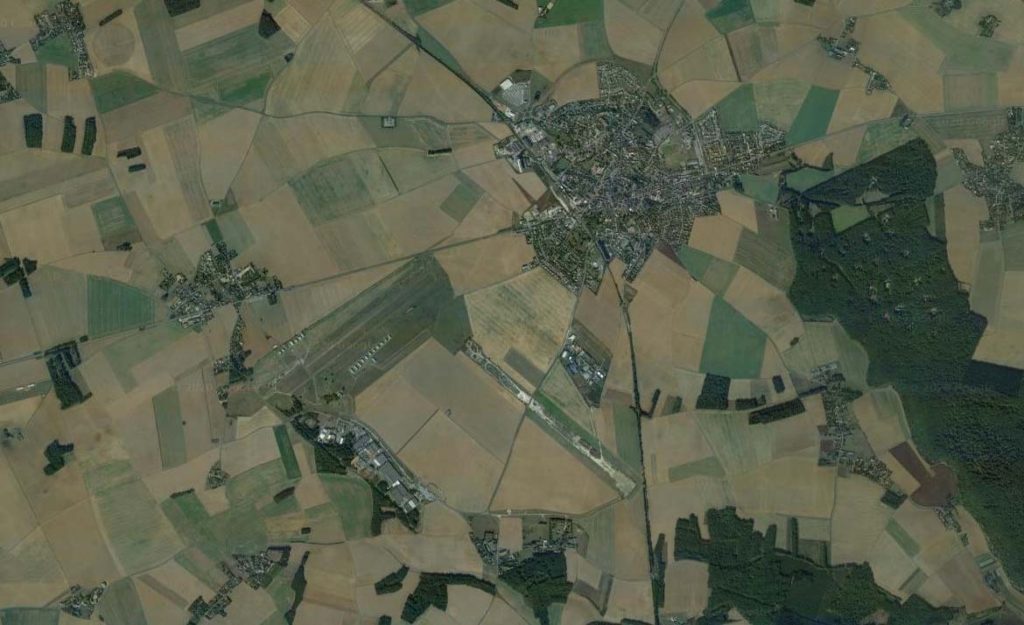
The airfield at Saint-André-de-l’Eure as it appears today.
Her original runways are unusable and have been left untouched since the war. As such, the airfield is a real time capsule.
Used as a base for German interceptors, the base was actually not operational on 3 September 1943, being closed for renovations between July 1943 and and April 1944.
Captured by Commonwealth forces, the base was used by RAF fighter units and the US 442TCG. Today the airfield is home to a small museum, Ham & Jam, focusing on the wartime contribution of small liaison and artillery spotting aircraft.

